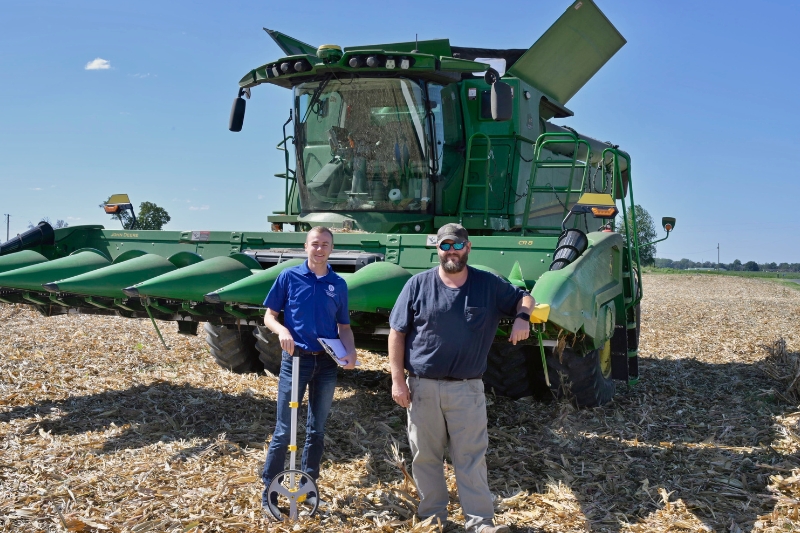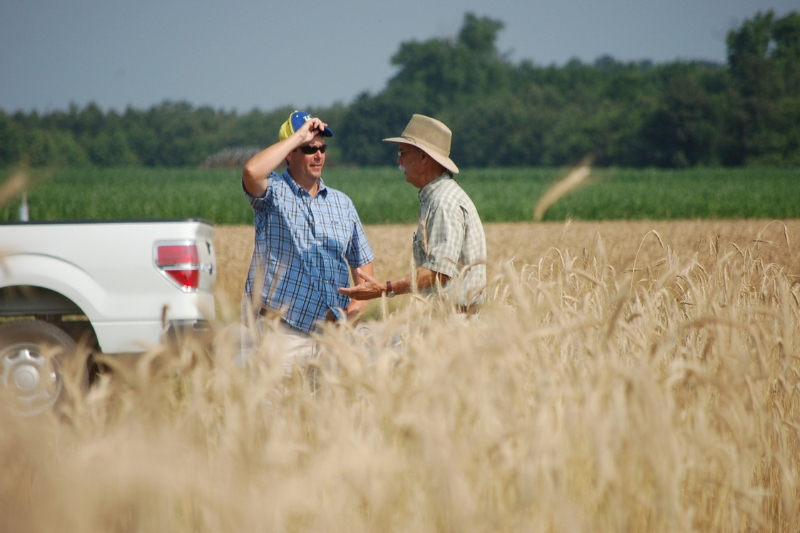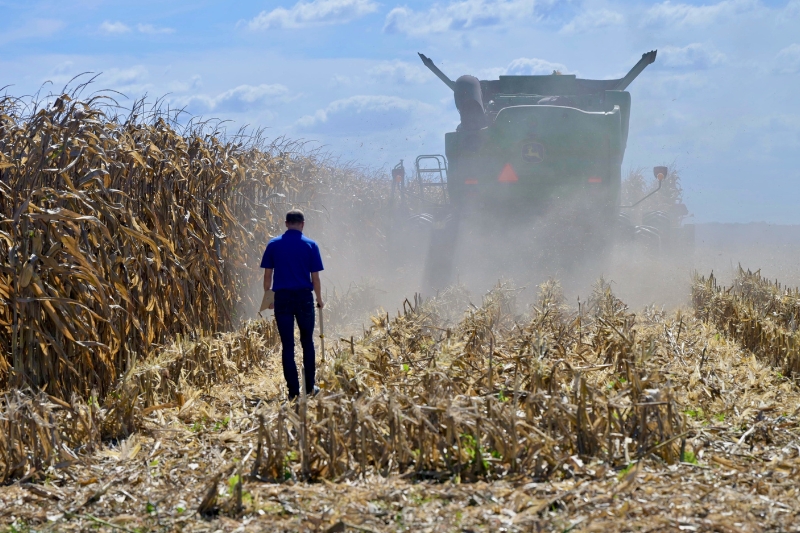


The county agent
Photos by Michele Walfred and courtesy of National 4-H November 10, 2025
UD Cooperative Extension’s embrace of tradition and innovation extends across the state of Delaware
October’s first day set a gorgeous, autumn backdrop — perfect conditions for Drew Harris to follow behind Jonathan Snow’s combine and get showered in corn husk debris.
During harvest season, Harris, the agriculture agent for the University of Delaware Cooperative Extension in Kent County, changes hats and becomes the Delaware supervisor for the National Corn Growers Association’s Yield Contest. The association designates Extension agents to provide unbiased verification that the harvest samples meet the requirements for the yield contest.
Snow appreciates Harris’s many hats.
“Extension is a good resource, and they help us stay ahead of the curve,” said Snow, who grows corn, wheat, soybeans and lima beans on 3,000 acres on his family farm in northern Kent County.
For Snow, his relationship with Harris is a matter of trust. He values the unbiased, research-based information Extension delivers.
“Extension will give you a heads up when they’re seeing things in your area that you may not be seeing yet,” Snow said. “If I have a problem in one of my fields, you’ve built that relationship; they know who you are.”
As an example, Snow cites southern rust, a new wind-borne disease that is migrating north.
“If I wasn’t sure what it looked like, or what the threshold was, Extension is a source you can call,” Snow said. “I can call the companies that I am buying products from, but at the end of the day, industry is there to support you because they are making money off of you, where the Extension agent is not.”
Norman Rockwell immortalized the special relationship between farmer and agent in his 1948 painting “The County Agent.” The entire family was present to hear what the county agent had to say. That concept of the venerated agriculture agent continues to endure today.

Cooperative Extension is a brand farmers and growers know — and deservedly so. Agriculture is Delaware’s leading economic driver. The agriculture industry is responsible for nearly $13 billion annually and provides more than 138,000 direct and affiliated jobs in the First State. These are powerful numbers for a small state, and Extension plays a significant role in keeping those numbers growing.
UD currently has two county agriculture agents across its three counties. County Extension agents serve as the conduit for farmers to access the latest crop varieties, as well as research on pests and diseases conducted at UD’s Newark and Georgetown campuses. Harris and his Sussex County counterpart, Cory Whaley, currently cover the state until a new agent position is filled in New Castle.

Their day-to-day agendas are made easier through a combination of technological resources and expertise available at the University of Delaware.
UD’s Delaware Environment Observing System (DEOS) provides crucial weather information, and the Delaware Irrigation Management System (DIMS) website delivers resources for farmers and crop consultants to know when and how much irrigation to supply crops. For a definitive diagnosis on plant and crop diseases, the UD Plant Diagnostic Clinic is the go-to resource.
When support shifts from agronomics to livestock, the county agents turn to Susan Garey, Extension animal science agent and Delaware 4-H animal science coordinator. Set in Delaware, if Rockwell were to reprise his original image today, it would be Garey providing advice about the dairy cow.

County agriculture agents also have a secret weapon to deploy — a team of Extension specialists, agronomists, pathologists, entomologists, weed specialists, and fruit and vegetable specialists who are only a phone call away.
While Extension continues to honor its agricultural roots, a lot has changed in the eight decades since Rockwell’s painting was published. Extension’s impact is felt far beyond agriculture.
Affiliated through land-grant universities in all 50 states, Delaware Cooperative Extension provides outreach through the state’s two land-grant universities, the University of Delaware and Delaware State University. Nationwide, the U.S. Department of Agriculture reports 35,000 agents and specialists are hard at work.
Extension is everywhere, often training service professionals who work directly with the public. The public link with Extension may not always be visible, but it is there.
It’s perhaps why the question, “What is Delaware Cooperative Extension?” often draws a blank response.

Lawn care companies, landscapers, golf courses, food handlers, food service workers, commercial greenhouses, nurseries and pest control operators receive continuing education from Cooperative Extension. Updates on native and invasive plants and insects fall under Extension’s broad purview.
The quality of watersheds, rivers and ponds, forests and open spaces owes a great deal to Extension’s implementation of the state’s Nutrient Management program, which has kept 157 tons of nitrogen and six and a half tons of phosphorus out of local waterways.
Health and Well-being agents promote healthy living, exercise and walking clubs and demonstrate diabetes recipes. They partner with food banks, libraries and community gardens to encourage families to make wise, nutritious food choices.
More than 36,000 schoolchildren benefit from 4-H curricula in citizenship, leadership, and Science, Technology, Engineering, Arts and Mathematics (STEAM) projects. 4-H reaches young people through traditional clubs, afterschool programs and day and overnight camps.
Cooperative Extension multiplies its outreach through the power of highly trained volunteers. There’s a good chance your neighbor might be a 4-H Leader, Master Naturalist, Master Health and Well-being Educator or Master Gardener. In Delaware, Extension volunteer services across all program areas provide an impressive benefit to the state, valued at well more than $1 million annually.
Erik Ervin, associate dean and interim director of UD Cooperative Extension, is proud to lead what he believes is a powerful organization for his state.
“Extension professionals are the definition of public servants, gaining satisfaction from their essential roles in their communities,” Ervin said. “We personalize the role of extending knowledge and improving lives. Cooperative Extension has, and continues to play, a vital role in keeping our country healthy and economically prosperous.”
Contact Us
Have a UDaily story idea?
Contact us at ocm@udel.edu
Members of the press
Contact us at mediarelations@udel.edu or visit the Media Relations website

